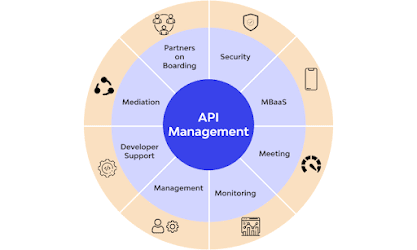API management is the process by which an organization creates, oversees and controls application programming interfaces (APIs) in a secure, scalable environment. The goal is to ensure the needs of developers and applications that use an API are met throughout the API's lifecycle, maintain API availability and performance and translate API services into business revenue.
Importance of API management
API Security - Authentication, authorization, and encryption is necessary to prevent unauthorized API access and cyber threats. One example of this is rate limiting which helps prevent sudden spikes in traffic.
Traffic Control - Similar to rate limiting, load balancing strategies help to distribute API traffic efficiently through caching and route mapping. Furthermore, this helps improve performance by directing API calls to the correct endpoints.
API governance - This element of API management creates a consistent user experience. It also includes API discoverability, lifecycle management, documentation and reusability. API governance allows developers to ensure that each API program is built proactively and fulfills a specific goal that adds value to the business. As mobile devices have become ubiquitous for engaging with applications, effective API governance helps developers create rich, complex APIs that improve the mobile user experience.
API Analytics - Insights into API usage patterns, performance, and adoption not only helps with identifying issues and opportunities but it also gives insight into your return on investment.
Benefits of API management
- The ability to make data-driven decisions through business insights gained from API analytics.
- Protection from security threats that affect APIs.
- Detailed API documentation to attract developers and inform users.
- Centralized visibility that lets organizations see all their API connections in one place, reducing security vulnerabilities, decreasing the number of repetitive APIs and identifying gaps for developers to address.
- API monetization that lets organizations share revenue with partners and track billing in real time.
- A positive user experience for API consumers.
- API agility and the ability to rapidly create new digital assets.
- A flexible, agile, adaptable and innovative ecosystem that simplifies the way people, processes and technology work together.
Challenges of API management
- API version control and compatibility issues.
- The API management infrastructure as a point of failure, resulting in unplanned downtime that can render client applications inoperable.
- Incomplete documentation of the APIs and the management system that can be labor-intensive, especially where the management system must handle many versions of diverse APIs.
- Security as a continuous threat at many levels, including the API's access to business data and the security of the API management infrastructure itself.
- Standardization issues that make it difficult to ensure all APIs are deployed and used in a common style and process.
- Scalability capabilities that are often poorly tested and rarely monitored throughout the API lifecycle.
- Lack of suitable analytics to track API management metrics and key performance indicators in a way that's suited to the needs of each API client.
API Management Tools and Technologies
API Gateway: The API gateway is the central component of an API management platform, acting as a single entry point for client requests to access backend services. It routes requests to the appropriate APIs and returns responses to clients. The gateway handles cross-cutting concerns like security, analytics, and performance optimization across all APIs. It provides centralized access control, usage monitoring, and improves efficiency by offloading common tasks from the services. Overall, the API gateway simplifies and secures communication with multiple backend APIs.
Developer Portal: A developer portal (sometimes called an API portal) is a central place where API providers and consumers collaborate and share. From a providers standpoint, the portal is where API developers can configure endpoints, document functionality, manage user access, and generate tokens or client keys. Consumers can register their application in the API portal, learn more about the functionality and exposed methods of an API, reset credentials, or raise service requests for additional support.
Analytic Tools: API management platforms often contain API analytics capabilities to track and visualize API usage metrics. Analytics dashboards can showcase important data points like total API calls, response times, throughput, uptime, adoption trends, and usage by application, developer, or geographic location.
API Policy Manager: The policy manager controls the API management policy lifecycles. Some API management platforms provide out of box policy control mechanisms that can ensure authentication and authorization, transform incoming requests, check performance, and route API traffic without refactoring existing code. You can hierarchically enable policies. For example, starting at the organization's root level, then the project level, and then at an individual API level.
API Key Management: API keys enable secure access to APIs. Users provide a unique key alongside requests, allowing the API to validate their identity. Requiring API keys is a best practice for authentication. API management platforms simplify API key management through built in capabilities. This allows providers to easily restrict API access, control data usage, and limit resource utilization by mandating API key usage. Overall, API key handling in API management platforms enhances security through streamlined, centralized access control.





No comments:
Post a Comment